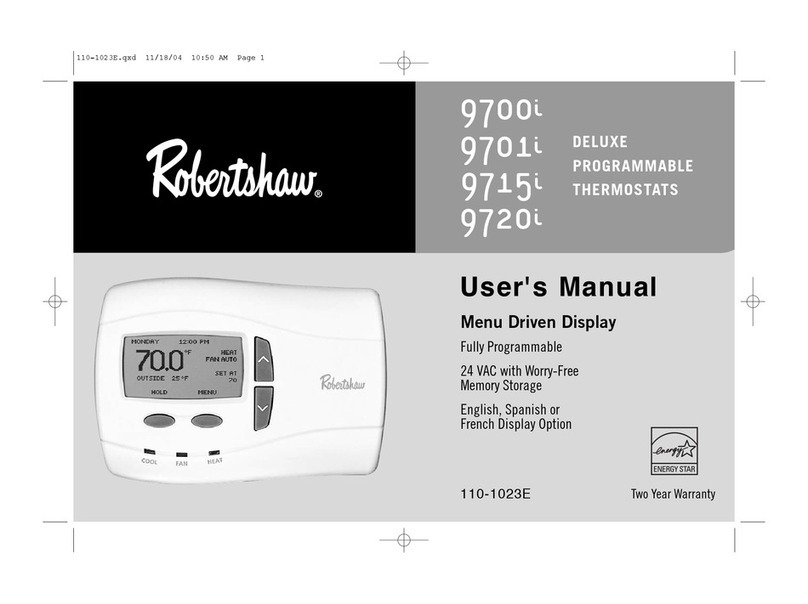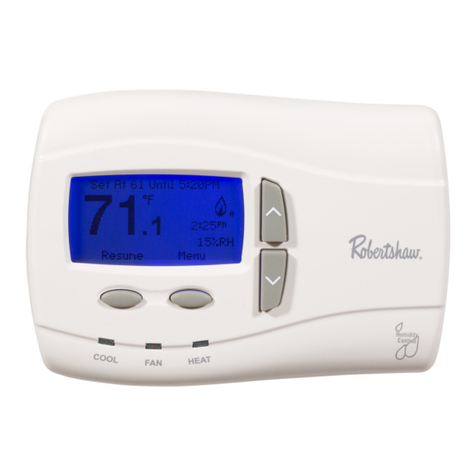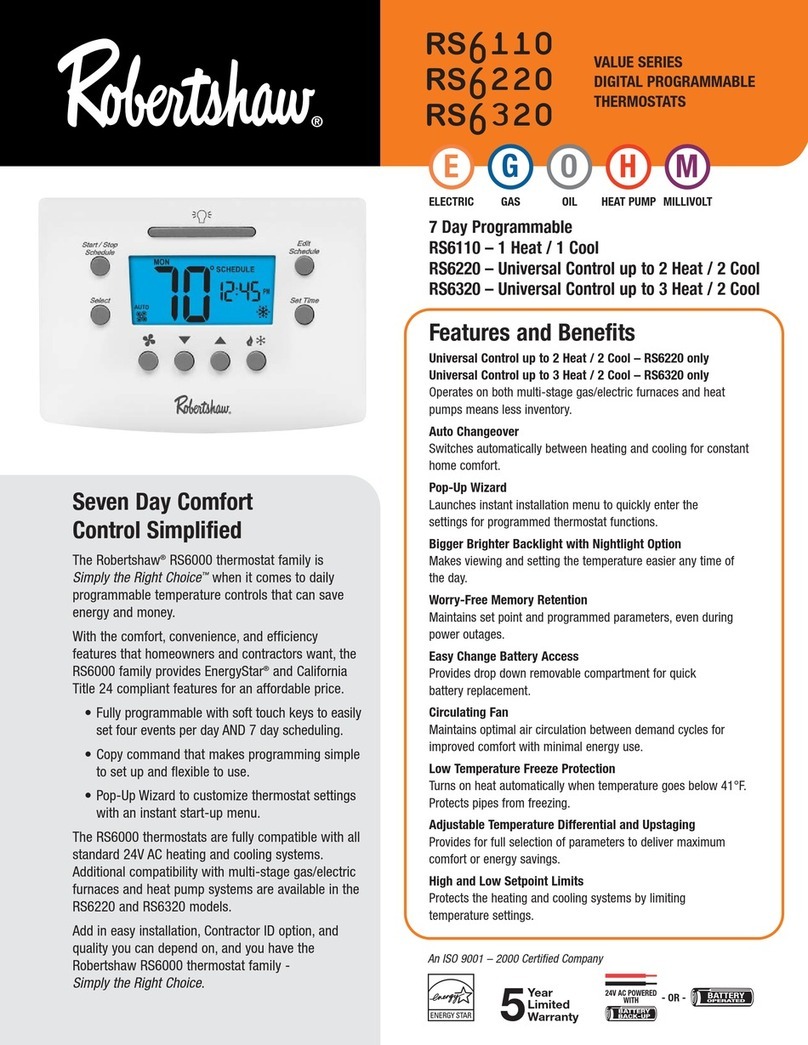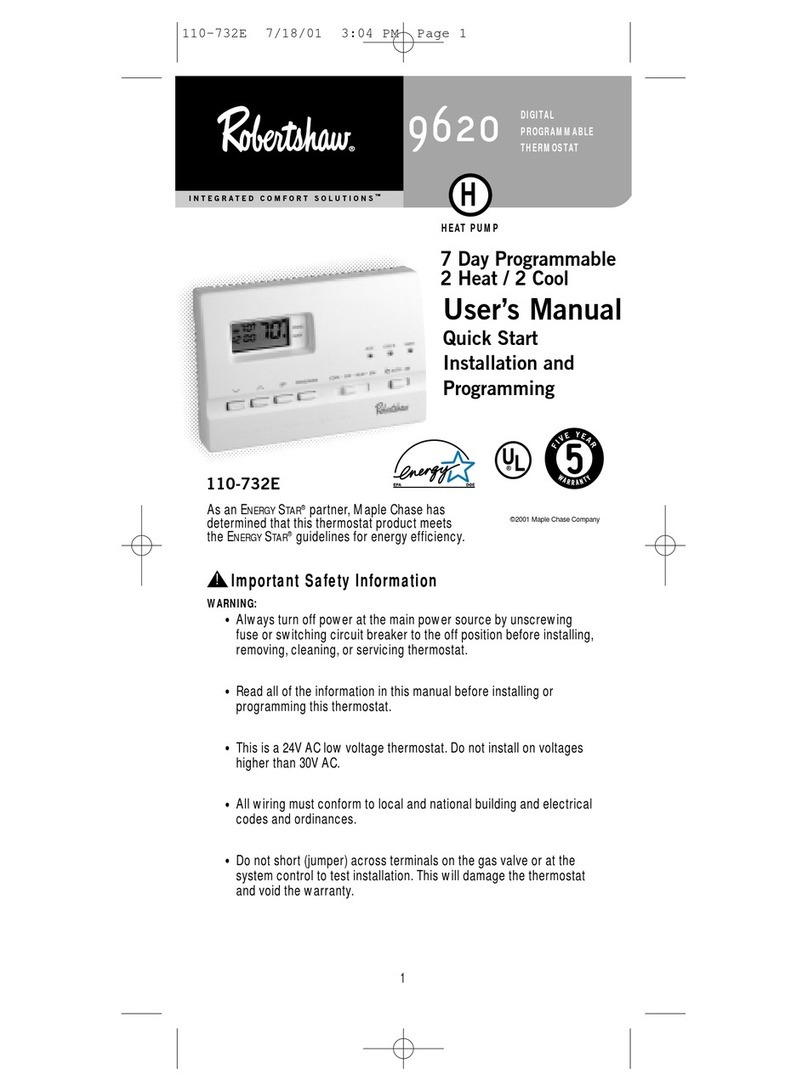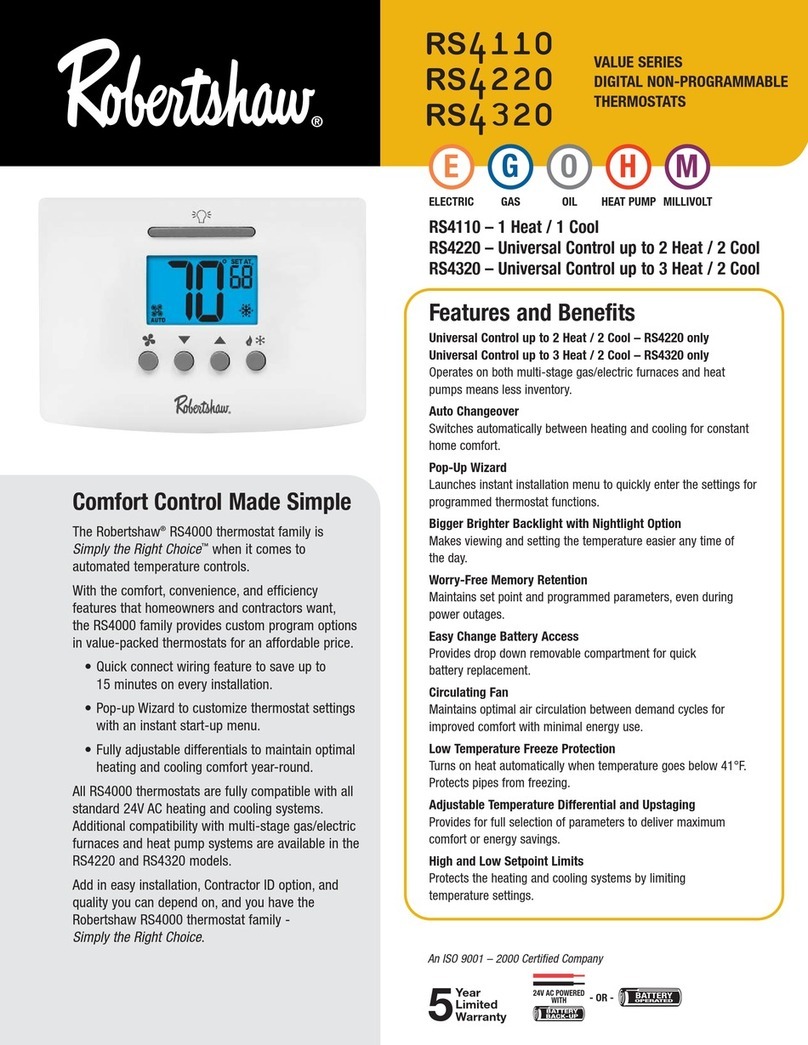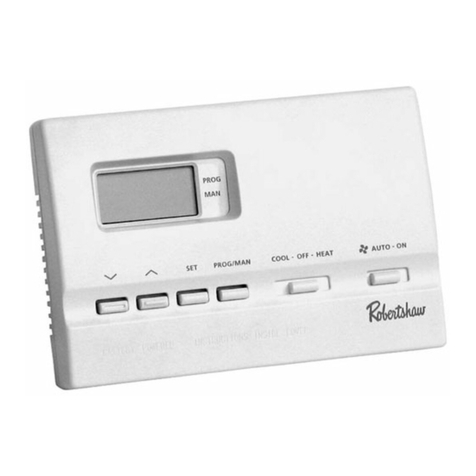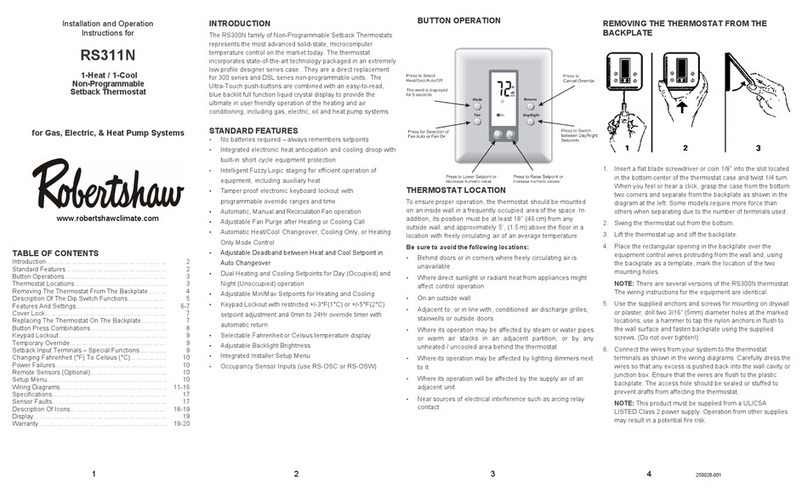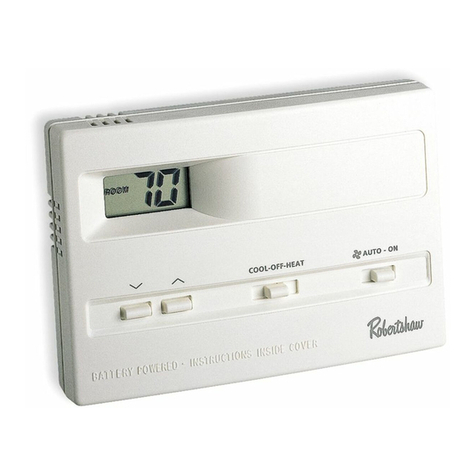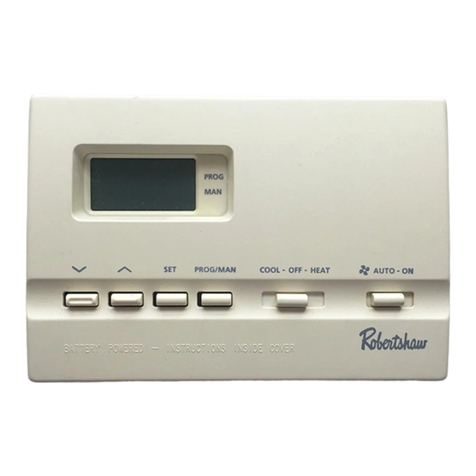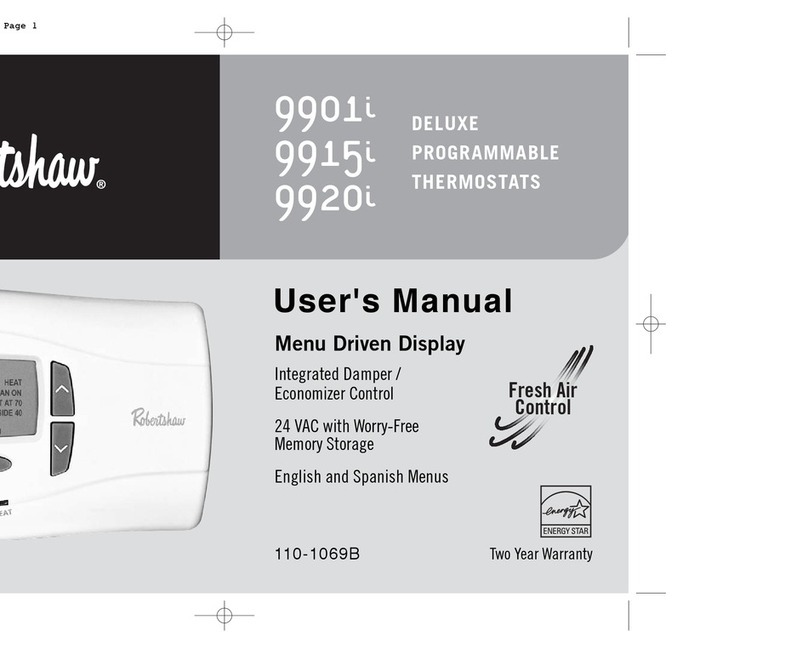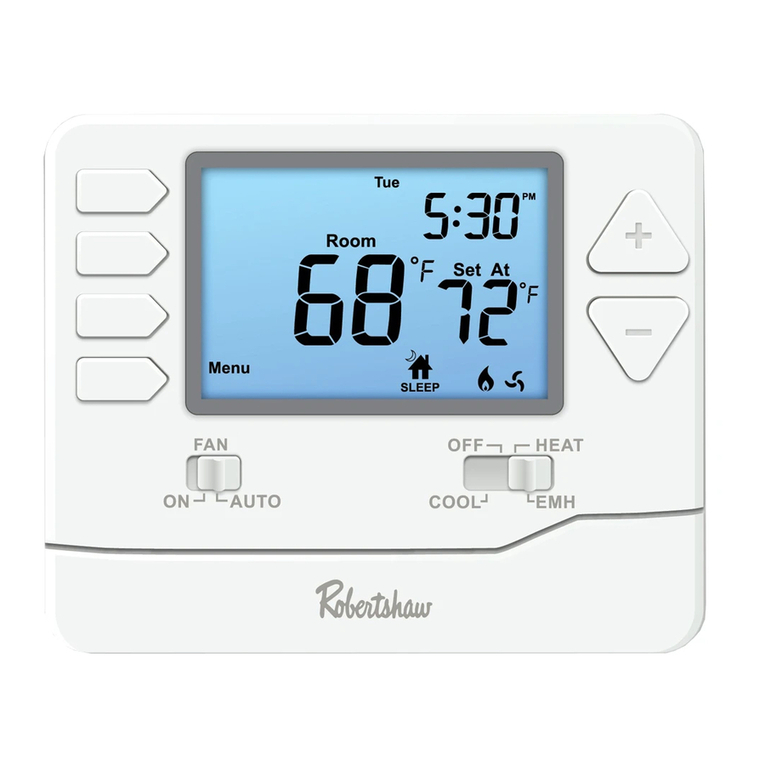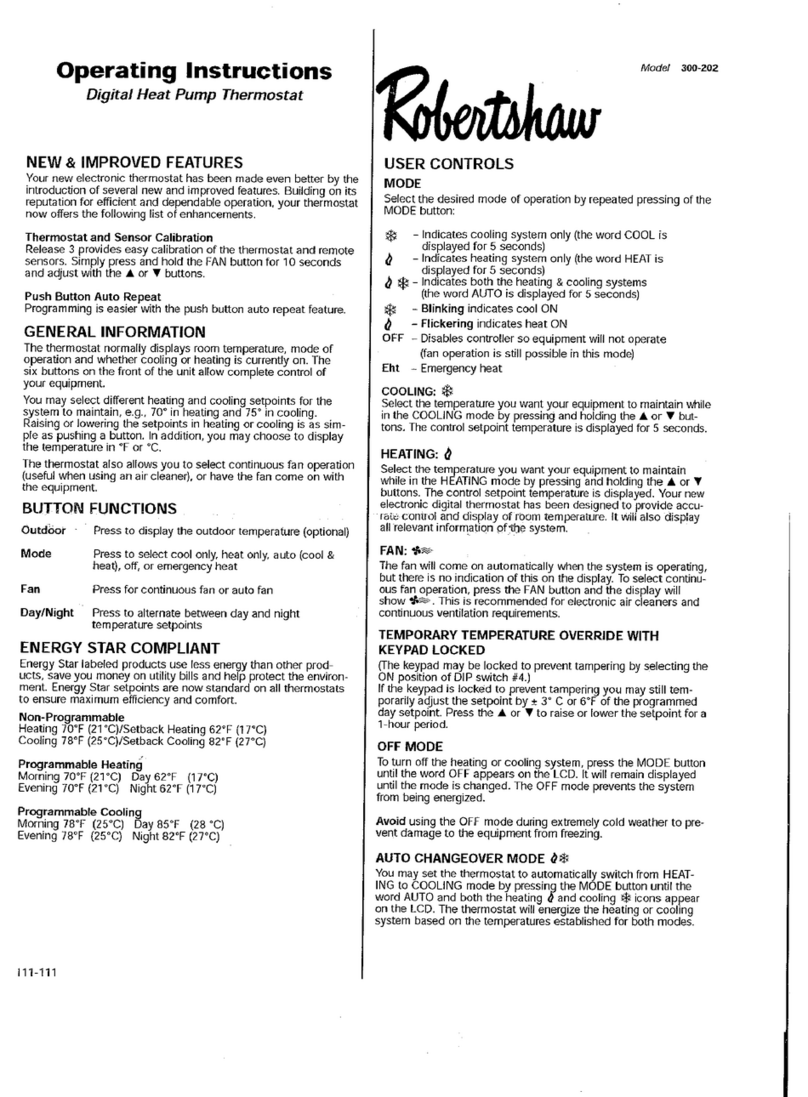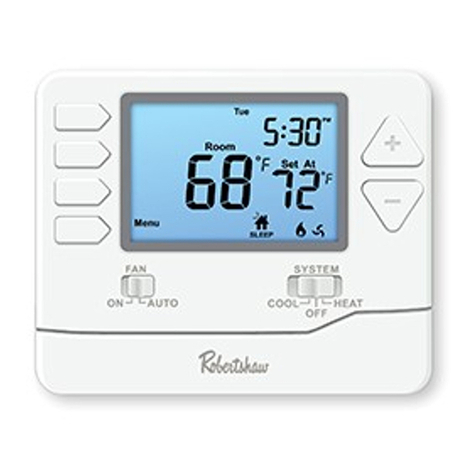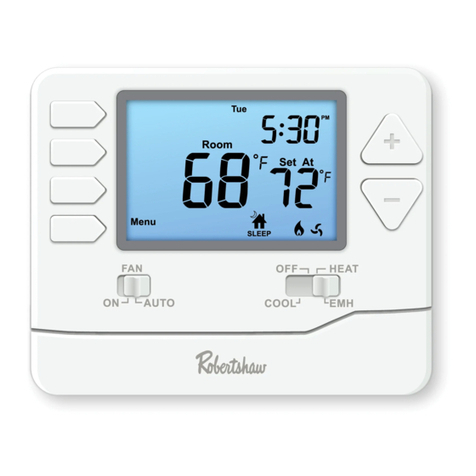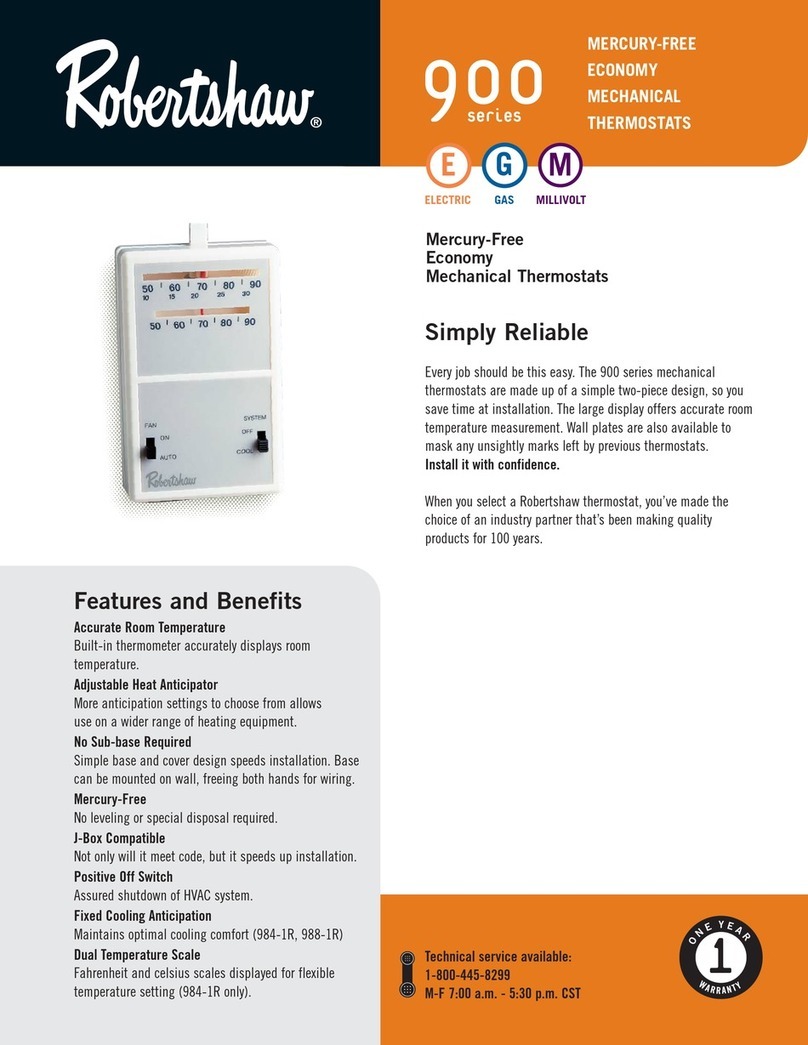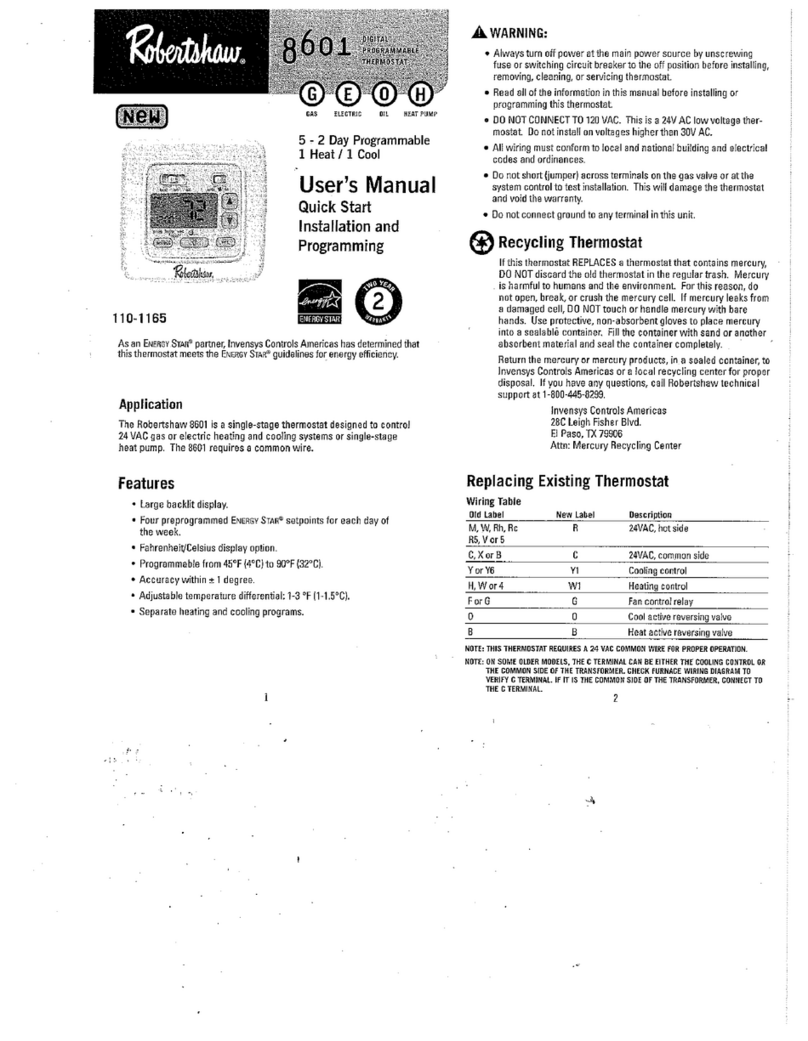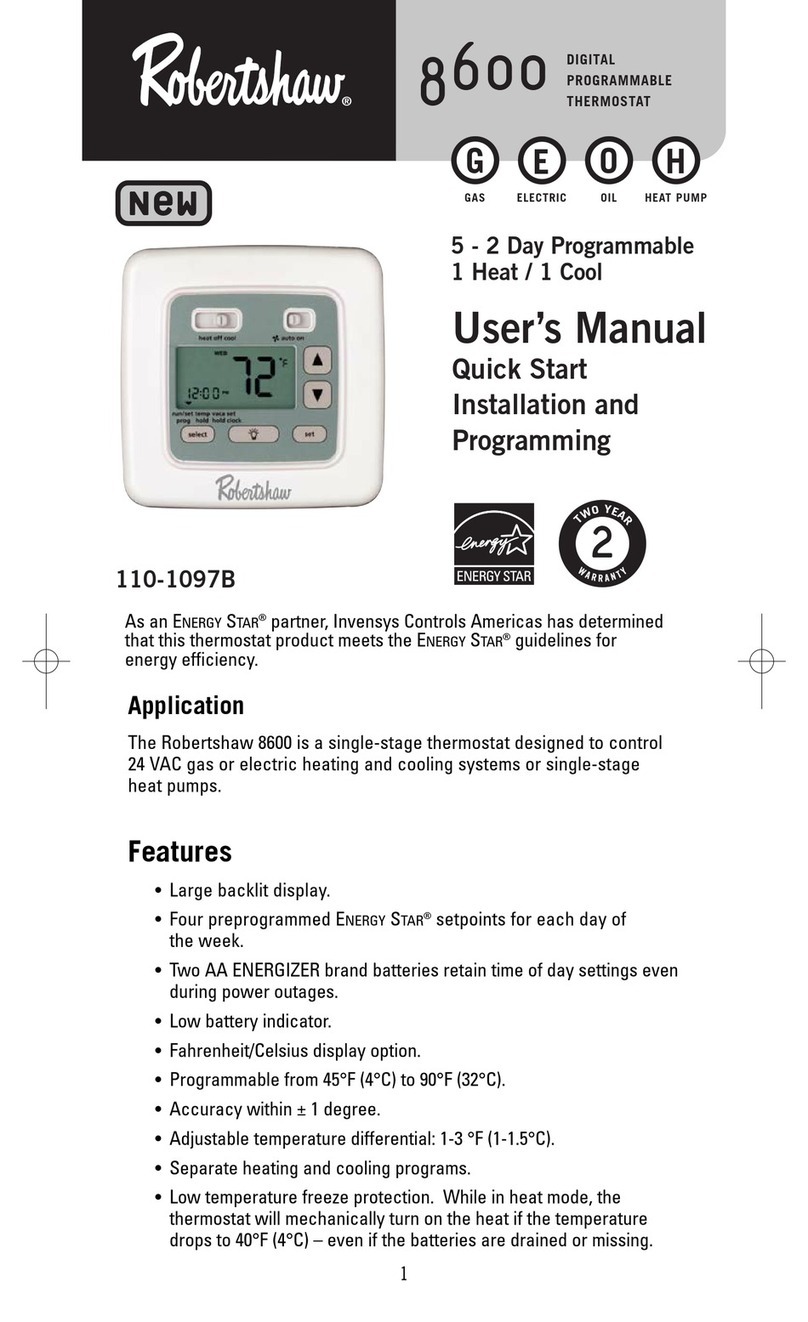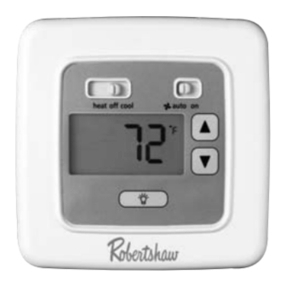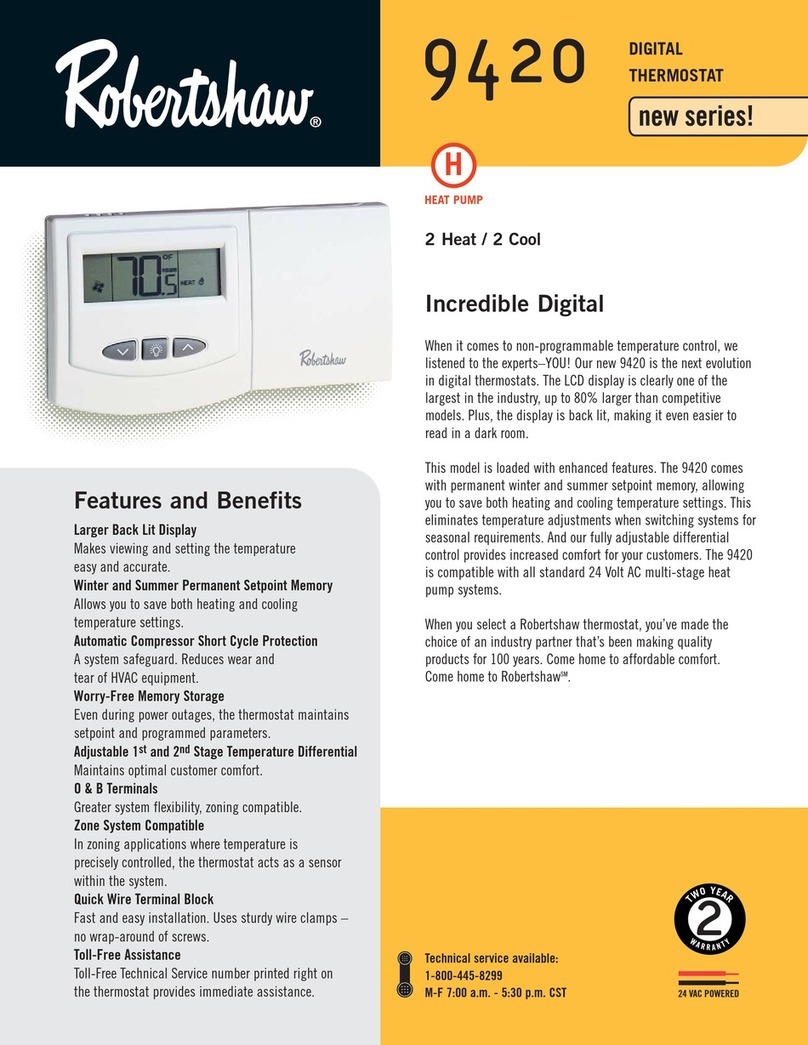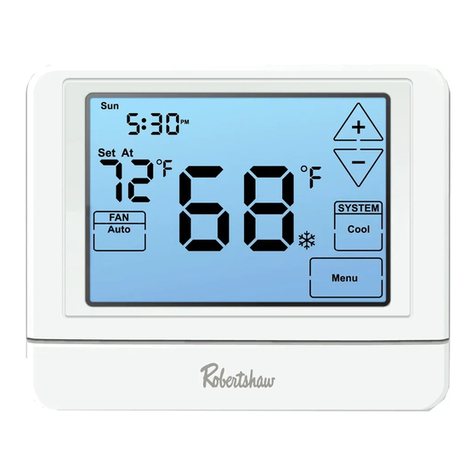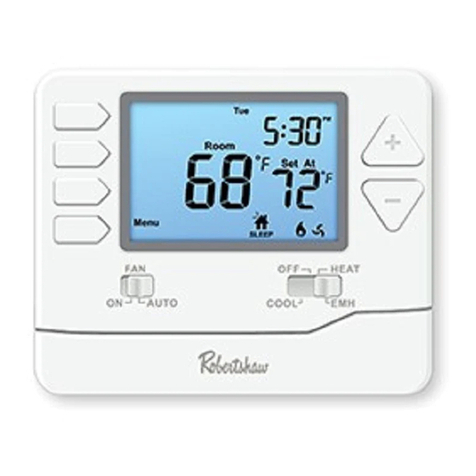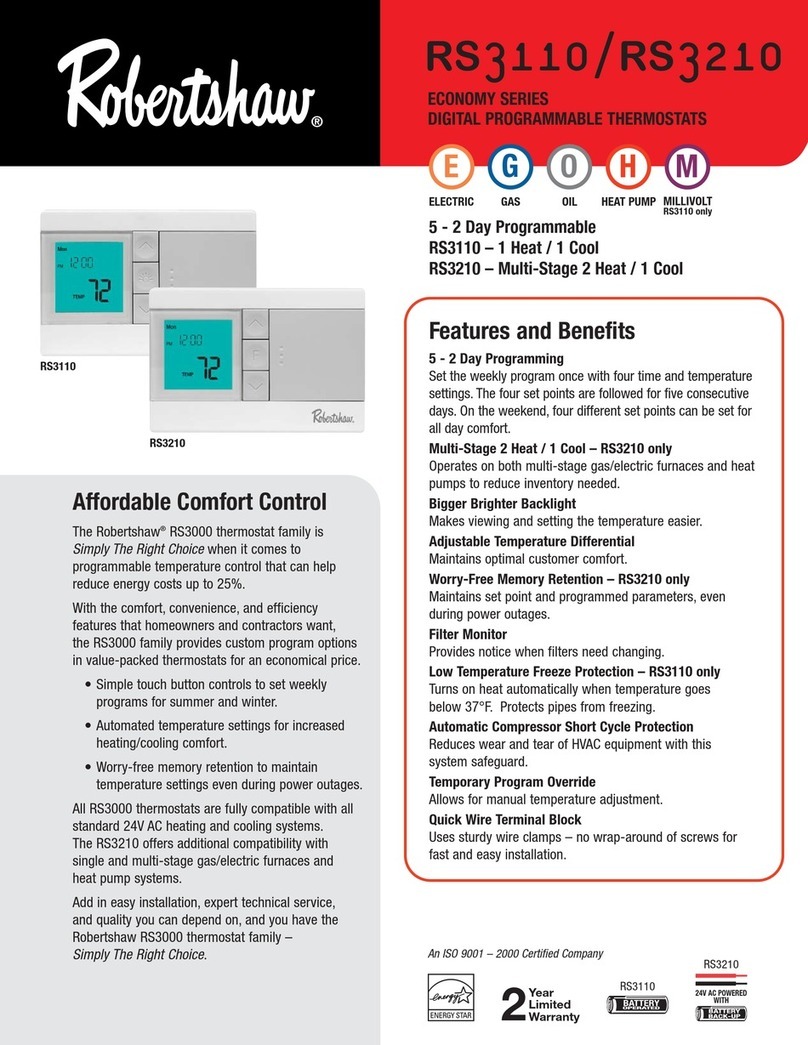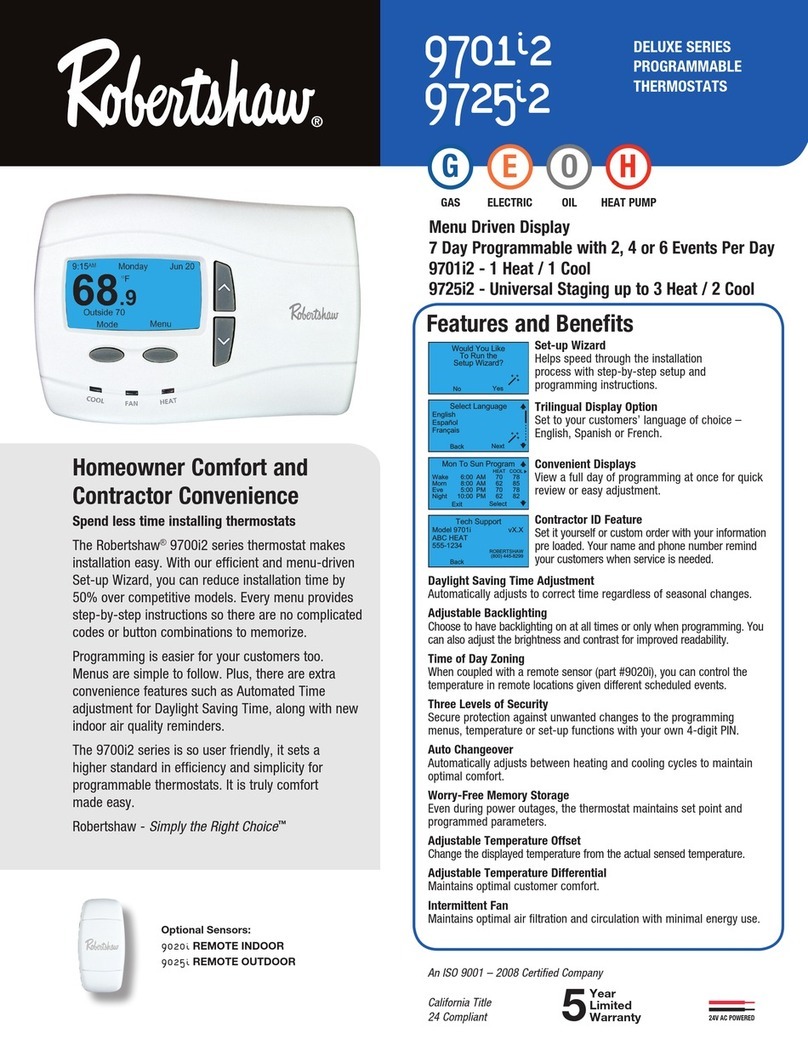
5 6 7 8
DESCRIPTION OF THE DIP SWITCH FUNCTIONS
DIP Switch 1 : GE/HP Operation
Place DIP Switch 1 to OFF position for Gas/Electric fur
nace
operation.
Place DIP Switch 1 to ON position for Heat Pump operation.
DIP Switch 2 : CLK Terminal Operation
Place DIP Switch 2 to OFF position to allow a short across the
CLK terminals via contact closure or Robertshaw® Occupancy
Sensor to engage Night (Unoccupied) operation until released.
Place DIP Switch 2 to ON position to allow a short to change the
thermostat to OFF mode until released.
DIP Switch 3 : 2 Minute or 4 Minute Minimum Off Times
When DIP Switch 3 is in the ON position, the minimum OFF time
is 2 minutes. When in the OFF position it is set to 4 minutes. The
system will allow equipment recovery for 2 or 4 minutes before
turning on again. This is also known
as
short cycle protection.
DIP Switch 4 : Unlocked/Locked Keypad
When DIP Switch 4 is in the ON position, all buttons are disabled
with the exception of the UP, DOWN and MODE button. Users
will be restricted to either a +/-3°F(2°C) or +/-5°F(3°C) range from
the Day (Occupied) setpoints as defined by DIP Switch 7. Users
will still be able to alternate between HEAT and COOL.
DIP Switch 5 : Plenum Fan Switch /Add-On Heat Pump
DIP Switch 5 is used to determine when the
fan
needs
to be
turned on.
Place DIP Switch 5 to OFF and DIP Switch 1 to OFF to have the
fan turn on immediately when there is a call for heat.
(Requir
ed
with electric
heat.)
Place DIP Switch 5 to ON and DIP Switch 1 to OFF to
have
the
plenum switch operate the fan.
Place DIP Switch 5 to OFF and DIP Switch 1 to ON for normal
heat
pump operation.
Place DIP Switch 5 to ON and DIP Switch 1 to ON for Add-On
(Dual-Fuel)
Heat Pump operation.
DIP Switch 6
:
Multi-Stage System Operation Place DIP Switch 6 to
OFF
position for single-stage applications. (single-stage compressors
and
heaters)
Place DIP Switch 6 to ON position for multi-stage applications.
(two-stage compressors and heaters)
DIP Switch 7
:
Temporary Override Adjustment Range
Place DIP Switch 7 to OFF to limit temporary adjustments to
+/-3°F(2°C).
Place DIP Switch 7 to ON limit temporary adjustments to
+/-5°F(3°C) .
DIP Switch 8
:
Remote Sensor Operation
Place DIP Switch 8 to OFF to only use the remote indoor
sensor
(10-528 or RS300-528)
for temperatur
e
control.
Place DIP Switch 8 to ON to average the thermostat’s inter
nal
sensor with the remote indoor sensor(s).
NOTE: If no remote sensor is used, the thermostat will default to
the thermostat sensor regardless of the DIP Switch setting.
FEATURES AND SETTINGS
LED #1 (GREEN):
Filter Indicator
This LED will illuminate when a signal is received from Terminal
LED1 on the Terminal block. The Green (left) LED at the top of
the thermostat and if selected by the software, the FILTER icon in
the display will turn on, indicating the filter needs to be changed.
LED #2 (YELLOW): Service Indicator
This LED will illuminate when a signal is received from Terminal
LED2 on the Terminal block. This terminal is usually connected to
the L terminal on a Heat Pump. When a signal is received, the
yellow (right) LED at the top of the thermostat will turn on and if
selected by the software, the WRENCH icon in the display will
turn on, indicating service is required.
LED #3 (RED):
Auxiliary/Emergency Heat Indicator
(no associated
scr
ew terminal)
The thermostat is equipped with an LED that indicates when the
system has engaged auxiliary heat mode or emergency heat
mode. It is the red (center) LED.
RS1 – RS2 – RS+V:
Remote Sensor Bus
Used for connection of a wide variety of Robertshaw® remote
sensors, allowing installation flexibility and additional information
from the sensor communications bus. It also allows the
thermostat to be placed in an area away from view.
Add-On (Dual-Fuel) Heat Pump Control
If needed, the thermostat will perform the function of a fossil fuel
kit. When in this mode, the thermostat will turn off the compressor
with a call for AUX heat. When Switch 1 and Switch 5 are in the
ON position, the thermostat allows the compressor and the AUX
heat to be on simultaneously.
Economizer with Adjustable Outside Air Threshold and
Compressor Delay (active only during ‘Day’ operation)
When an economizer damper is connected and either a 10-529 or
RS300-529 outdoor sensor is installed, the Economizer feature
may be enabled to turn on at or below a programmable outdoor
temperature threshold to conserve energy by not running the
compressor when there is a call for cooling. The outdoor
temperature setting may be set from 45°F(7°C) to 80°F(26°C) in
1° increments (default is 70°F). If the outdoor temperature is at or
below the threshold, the thermostat will engage the economizer
first. The economizer compressor delay is adjustable from 10 to
30 minutes in 1 minute increments (default is 20 minutes). If the
economizer can not satisfy the cooling setpoint by the end of the
economizer compressor delay, the compressor will be engaged
and normal staging will occur along with the free cooling from the
economizer. Note: If the outdoor temperature rises above the
threshold the economizer will be closed.
After a power failure, the thermostat will delay the heating/ cooling
equipment start-up by 8-40 seconds. When multiple Robertshaw®
RS300N thermostats are used, this minimizes the ‘in rush’ current
(electric power usage) as it reduces the number of HVAC units
that will be turned on simultaneously.
High & Low Balance Point Configuration
If the thermostat is being used as a Heat Pump thermostat, with
DIP Switch #1 in the ON position and an outdoor sensor (10-529
or RS300-529) is connected, the thermostat can be configured to
disable the use of auxiliary heat during warmer weather and to
lock out the compressor during colder weather.
FEATURES AND SETTINGS, continued
To display/set the High and Low balance points, use the Setup
Menu. The display will indicate the high or low balance point and
the selected temperature. Press the UP or DOWN button to adjust
the balance point temperature.
NOTE: Refer to the heat pump equipment manual for temperature
cut-offs on the equipment.
Override Timer Configuration
The temporary override time can be adjusted from 0 min to 24
hours, in 10 minute increments. (0min is a complete lockout).
The default time is 8 hours. To display/set the Override time,
either use the integrated Setup Menu or press the MODE and
DAY/NIGHT buttons simultaneously, then press the UP or
DOWN button.
Recirculation Fan Configuration
Using the Setup Menu, Recirculation Fan can be set for up to 30
minutes of fan operation per hour. Default is 0 min.
Fan Purge Configuration
Using the Setup Menu, Fan Purge time can be set for up to 60
seconds of fan run after a heating or cooling call in order to
release remaining conditioned air into the space. Default is 0 sec.
Temperature Calibration (De-calibration)
The thermostat is pre-calibrated at the factory, but in some
installations, lack of airflow at the sensor or proximity to other
warming or cooling source may cause the temperature to be off
by a few degrees. To adjust the room temperature reading use
the Setup Menu. To restore the thermostat to factory calibration,
use the alternate method on page 8 (Press & Hold Fan button).
Deadband Configuration
Using the Setup Menu, when in Auto Mode the minimum
difference between heating and cooling setpoints can be adjusted
from 2°F(1°C) to 8°F(4°C). The default is 2°F(1°C).
COVER LOCK
The cover may be locked to prevent unauthorized access by
adding the clear plastic lock (included in the installation bag).
Remove the thermostat from the backplate and place the clear
plastic lock in the backplate as shown below. Replace the
thermostat and close the cover. The cover now is locked. To
open, use a screwdriver to carefully push the lock back, allowing
the cover to open.
REPLACING THE THERMOSTAT ON THE
BACKPLATE
1. Position the thermostat on the hinged tabs located at the top
of the backplate.
2. Gently swing the thermostat down and press on the bottom
center edge until it snaps in place.
BUTTON PRESS COMBINATIONS
Changes from COOL to HEAT to
AUTO to EMERGENCY HEAT to OFF.
Sets the fan ON (continuous), or AUTO
(operates with the equipment), or CIRC
(recirculation).
When the keypad is locked, cancels
temporary setpoint overrides and
resumes previous operating mode.
Alternates between Day (Occupied)
and Night (UnOccupied) setpoints.
Increments the blinking numerical or
icon segments of the display.
Decrements the blinking numerical or
icon segments of the display.
Toggles between °F and °C.
Displays Remote Sensor values in the
upper display. Press both, then press
UP or DOWN to rotate through the
available sensors.
Changes backlight setting. On, dim or
off. (After 15 seconds of inactivity)
Changes the Override Timer. Press
both, then press UP or DOWN to
change the override time from 0
minutes to 24hrs in 10 minute
increments
PRESS & HOLD (12 seconds unless stated otherwise)
Resets the thermostat to factory
defaults. Press and hold the MODE
button to show the number of resets.
Press the MODE button three more
times to reset the defaults.
Enters thermostat sensor de-calibration
mode. Allows a temperature offset of
up to +/-6°F. To remove the de-
calibration, press and hold the MODE
Allows for adjustment of High and Low
balance points when displaying outdoor
temperature (hold for 5 seconds).
NOTE: There must be an outdoor
sensor attached for this feature to be
